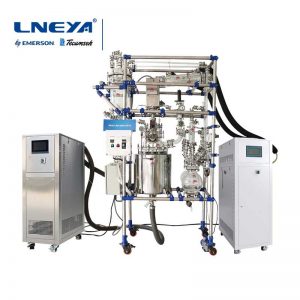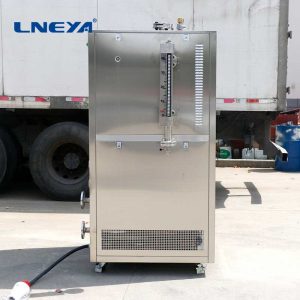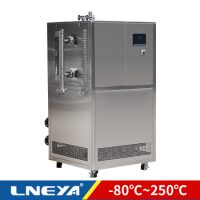Recirculating Chiller For Rotary Evaporator
Choosing the right cooling method for a laboratory rotary evaporator can have an unimaginable impact on the performance, economy and efficiency of the overall system. As a necessary stage of the distillation process, the commonly used condensation methods currently include: using dry ice condensers, equipped with or building a cooling cycle system by yourself, and using tap water for steam cooling. But in most cases, you need to buy recirculating chiller as supporting equipment.
Cuando el circulador refrigerado está en funcionamiento, enfría el refrigerante lleno en el depósito de agua a través de su sistema de refrigeración, y la bomba incorporada bombea el refrigerante a la tubería del condensador para absorber el calor del vapor en el condensador y lograr el efecto de condensación. El refrigerante con temperatura elevada vuelve al depósito de agua para enfriarse de nuevo. De este modo, el refrigerante circula y se intercambia para proporcionar una temperatura de condensación estable para el sistema de evaporación rotativa, al tiempo que se evitan eficazmente las fluctuaciones estacionales de temperatura que pueden producirse cuando se utiliza agua del grifo. Además, la elección de un refrigerador eficiente y respetuoso con el medio ambiente para sustituir el agua del grifo para la refrigeración también ayudará al laboratorio a ahorrar agua.
Important factors to consider when choosing the right recirculating chiller include:
Temperatura mínima de condensación y capacidad de refrigeración correspondiente
02. Cycle pressure
03. Circulation flow
04. Suitable accessories
05. Chiller selection guide
Temperatura mínima de condensación y capacidad de refrigeración correspondiente
The minimum temperature of the coolant needs to be below the temperature at which the rotovap condenser will condense the solvent vapor at an optimal rate. This temperature is determined by the boiling point of the solvent. When selecting and setting the temperature of the recirculating chiller, it is generally recommended to follow the “rule of 20”, that is, set a temperature difference of 20°C between the heating pot temperature and the steam temperature, and between the steam temperature and the condenser temperature. For example, set the heating pot temperature to 60°C, adjust the vacuum settings of the system to generate solvent vapor at 40°C, and operate condensation at 20°C. Therefore, the solvent vapor temperature is 20°C lower than the heating pot temperature, and the condenser temperature is 20°C lower than the steam temperature.
The lower the temperature that the recirculating chiller can provide, the better the condensation effect. The recirculating chiller usually has the maximum cooling capacity at 20°C or normal temperature, that is, the maximum cooling power parameter under ideal conditions, which is often the nominal cooling power marked by the manufacturer. For example, our company’s LX recirculating chiller has a cooling capacity of 1000W when the water temperature is 20°C, and the cooling capacity is halved when the water temperature is 5°C, that is, the cooling capacity is about 500W.
As the temperature gets lower, the cooling capacity that the recirculating chiller can achieve decreases. If the recirculating chiller is at the set temperature, the cooling capacity is not enough to take away the heat of the cooling liquid in the distillation, which means that the cooling liquid will not be able to reach the set temperature in the actual distillation, and the ideal condensation efficiency will not be achieved. Therefore, the cooling effect of the recirculating chiller needs to comprehensively consider the two parameters of temperature and cooling capacity.
If the rotary evaporator needs to distill multiple solvents, then the cooling capacity of the recirculating chiller should be selected according to the required minimum condensation temperature. By checking the product specifications, you will find that the recirculating chiller has different cooling capacities corresponding to different temperatures. If the condenser is required to work at a relatively low temperature, it is necessary to have a deep understanding of the cooling capacity of the recirculating chiller at a relatively low temperature, that is, the cooling capacity.
If the recirculating chiller has insufficient power at its set temperature, it means that the cooling liquid will not be able to reach the set temperature during the actual distillation, so that it will not be able to provide enough heat transfer effect to effectively condense the steam. Vapor that cannot be cooled in time will be sucked into the vacuum pump, increasing wear and shortening the service life of pump components, and may even cause irreparable damage. In addition, if your recirculating chiller has an over-temperature alarm function, setting the temperature too low may cause the equipment to alarm and shut down, and the distillation experiment will be interrupted.
02. Cycle pressure
Another important factor to consider is the pressure range of the recirculating chiller’s recirculating pump. The pump pressure for a recirculating chiller is usually in the range of 10-15 psi (0.67-1.03 bar). If the pump pressure is too low, once there is a certain height difference between the rotary evaporator and the refrigerated circulator (for example, the equipment is placed under the test bench), the coolant will not be able to circulate effectively in the condenser. If the pump pressure is too high, the risk of rupture inside the glass condenser due to excessive coolant pressure increases dramatically. The maximum internal pressure of a common glass condenser is 1.5bar, so it is necessary to pay attention to the applicable range of the pressure.
When purchasing a recirculating chiller, it is necessary to confirm the pressure range of the equipment and the working pressure range of the rotary evaporator condenser. In general, most equipment compatible with rotary evaporators has a maximum pump pressure of 11.5 psi (≈0.8 bar), making them suitable for use with glass condensers. If a positive displacement pump and a turbo pump are configured, they often have a higher output pressure, so more attention should be paid to their pump pressure range, so as to avoid the risk of glass condenser rupture due to the use of the corresponding recirculating chiller, or the cooling liquid caused by insufficient pump pressure. Cannot loop effectively.
03. Circulation flow
The pump flow rate of the recirculating chiller affects the residence time of the coolant in the condenser. The lower the flow rate, the longer the coolant stays in the condenser. As the temperature increases, the efficiency of heat transfer between the steam and the coolant decreases. In this case, there is an increased risk of insufficient condensation of solvent vapors.
Although the current flow of most recirculating chillers is sufficient relative to their cooling power, it is still necessary to pay attention to this point.
04. Suitable accessories
Coolant and enhanced cooling water pipeline, according to the temperature range, select the appropriate coolant.
If lower temperatures are required, ethanol or glycol mixtures are recommended. The common coolant is a mixture of ethylene glycol and water containing inhibitors. The working temperature ranges from -30 to +90°C and the ignition point is about 120°C. It is an ideal choice for most recirculating chillers to match the rotary evaporator. Note: Although ethanol does not freeze until 117.3°C, it is highly flammable and presents some risk. Care should be taken when using it as a coolant.
The cooling water line should be selected to match the chemical compatibility of the coolant used, the temperature range of the application, and the pressure rating. Failure to select the correct tubing will result in bursting of the tubing either immediately or over prolonged use. If operating at low temperatures, insulation jackets can be used to reduce heat loss due to ambient temperature effects.
05. Selection guide for recirculating chiller
For different rotary evaporation applications, we provide a variety of recirculating chillers to meet the individual needs of users.
Three basic points:
1. In order to protect the glass condenser, the maximum pump pressure of the cooling circulating water bath shall not exceed 2 bar.
2. In order to obtain the best distillation speed, it is recommended to follow the three-quarters principle: that is, at three-quarters of the height of the condenser and below, the steam should be effectively condensed, form liquid droplets and be discharged as condensate, and try to avoid steam Reaching the upper quarter of the condenser, the steam is sucked by the vacuum pump because it cannot be cooled in time, which affects the performance of the pump.
3. The top of the glass condenser should always maintain an effective low temperature state to avoid steam being sucked into the vacuum pump.
Our company can provide chillers with various temperatures, refrigerating capacity and circulating pressure.
The temperature of the condenser is a key factor affecting the recovery rate, and our recirculating chiller is very suitable for supporting rotary evaporation applications. Low-temperature -20°C, -40°C low-temperature circulating fluid, supplemented by appropriate vacuum control, can effectively recover or evaporate organic solvents.
In the process of continuous distillation of a large amount of volatile solvents under reduced pressure, a suitable low-temperature cooling circulating fluid is generally required.
Soluciones personalizadas para su empresa
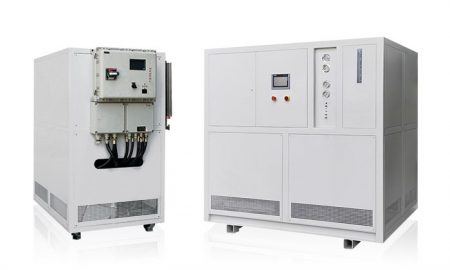
Refrigeradores de baja temperatura (por agua y por aire)
Rango de control de temperatura: -150°C a -5°C
Estamos especializados en la producción de refrigeradores de baja temperatura con un rango de control de temperatura de hasta -150°C, que pueden satisfacer las necesidades de refrigeración de diferentes industrias.
| Temperatura | Serie -25°C ~ -5°C | Serie -45°C ~ -10°C | Serie -60°C ~ -10°C | Serie -80°C ~ -30°C | Serie -110°C ~ -50°C |
| Capacidad de refrigeración | hasta 360 kW | hasta 360 kW | hasta 360 kW | hasta 270 kW | hasta 180 kW |
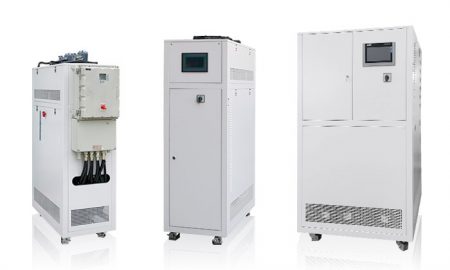
Enfriadoras de recirculación (Refrigeración por agua y por aire)
Rango de control de temperatura: -120°C a +30°C
Nuestro enfriador de recirculación adopta tecnología de refrigeración de baja temperatura, la temperatura es tan baja como -120℃, y varios accesorios son personalizables.
| Temperatura | Serie -25°C ~ +30°C | Serie -45°C ~ +30°C | Serie -60°C ~ -20°C | Serie -80°C ~ -20°C | Serie -120°C ~ -70°C |
| Capacidad de refrigeración | hasta 38 kW | hasta 12 kW | hasta 7,2 kW | hasta 7,2 kW | hasta 8,6 kW |
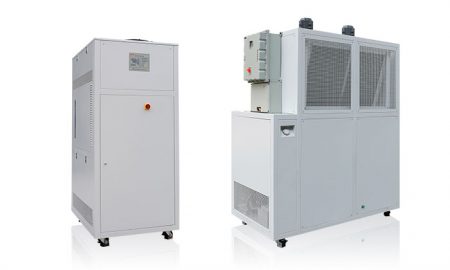
Refrigeradores de temperatura ambiente / Refrigeradores pequeños
Rango de control de temperatura: +5°C a +50°C
El enfriador puede utilizarse ampliamente en diversas industrias y laboratorios, y admite diseños personalizados.
| Temperatura | -18°C ~ +30°C | Serie +5°C ~ +35°C |
| Capacidad de refrigeración | hasta 0,9 kW | hasta 50 kW |
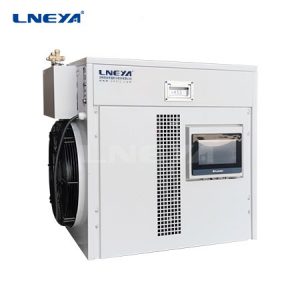
Equipos frigoríficos de refrigeración directa
Rango de control de temperatura: -120°C a -10°C
Es adecuado para lugares con poca superficie de intercambio de calor y gran intercambio de calor.
| Temperatura | -40°C ~ -10°C | -80°C ~ -35°C | -120°C ~ -90°C |
| Potencia del compresor | hasta 8CV | hasta 8CV*2 | hasta 45 CV*3 |

Enfriadoras de temperatura ultrabaja de refrigeración directa
Rango de control de temperatura: -150°C a -110°C
Soluciones personalizadas para su empresa.
| Temperatura | -150°C ~ -110°C |
| Capacidad de refrigeración | hasta 11 kW |
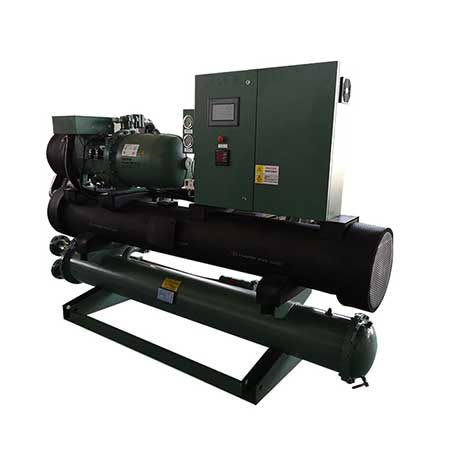
Refrigeradores de tornillo
Refrigeradores de tornillo de baja temperatura y refrigeradores de tornillo a temperatura ambiente
Soluciones personalizadas para su empresa.
| Temperatura | +5°C ~ +30°C | +5°C ~ +30°C | +5°C ~ +30°C | +5°C ~ +30°C | -25°C ~ +5°C | -25°C ~ +5°C |
| Capacidad de refrigeración | hasta 1027 kW (compresor único) | hasta 2134 kW (compresor doble) | hasta 934 kW (compresor único) | hasta 1940 kW (compresor doble) | hasta 467 kW (compresor único) | hasta 497 kW (compresor único) |
 LNEYA
LNEYA
 简体中文
简体中文












































































